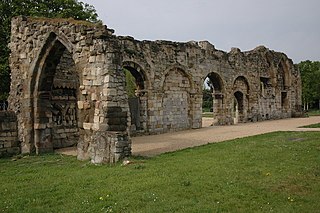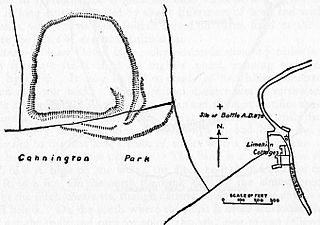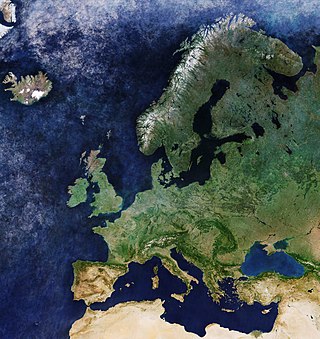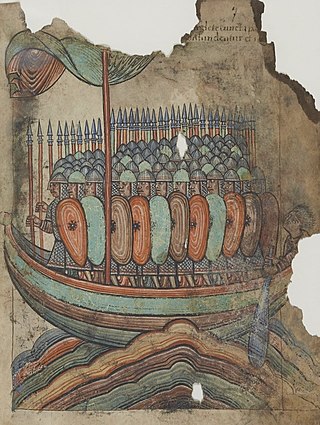Related Research Articles

Alfred the Great was King of the West Saxons from 871 to 886, and King of the Anglo-Saxons from 886 until his death in 899. He was the youngest son of King Æthelwulf and his first wife Osburh, who both died when Alfred was young. Three of Alfred's brothers, Æthelbald, Æthelberht and Æthelred, reigned in turn before him. Under Alfred's rule, considerable administrative and military reforms were introduced, prompting lasting change in England.

Æthelflæd, Lady of the Mercians ruled Mercia in the English Midlands from 911 until her death. She was the eldest daughter of Alfred the Great, king of the Anglo-Saxon kingdom of Wessex, and his wife Ealhswith.

The Danelaw was the part of England in which the laws of the Danes held sway and dominated those of the Anglo-Saxons. The Danelaw contrasts with the West Saxon law and the Mercian law. The term is first recorded in the early 11th century as Dena lage. The areas that constituted the Danelaw lie in northern and eastern England, long occupied by Danes and other Norsemen.
Guthrum was King of East Anglia in the late 9th century. Originally a native of Denmark, he was one of the leaders of the "Great Summer Army" that arrived in Reading during April 871 to join forces with the Great Heathen Army, whose intentions were to conquer the kingdoms of Anglo-Saxon England. The combined armies were successful in conquering the kingdoms of East Anglia, Mercia, and Northumbria, and overran Alfred the Great's Wessex, but were ultimately defeated by Alfred at the Battle of Edington in 878. The Danes retreated to their stronghold, where Alfred laid siege and eventually Guthrum surrendered.

Æthelred, Lord of the Mercians became ruler of English Mercia shortly after the death or disappearance of its last king, Ceolwulf II in 879. Æthelred's rule was confined to the western half, as eastern Mercia was then part of the Viking-ruled Danelaw. His ancestry is unknown. He was probably the leader of an unsuccessful Mercian invasion of Wales in 881, and soon afterwards he acknowledged the lordship of King Alfred the Great of Wessex. This alliance was cemented by the marriage of Æthelred to Alfred's daughter Æthelflæd.

Æthelwold or Æthelwald was the younger of two known sons of Æthelred I, King of Wessex from 865 to 871. Æthelwold and his brother Æthelhelm were still infants when their father the king died while fighting a Danish Viking invasion. The throne passed to the king's younger brother Alfred the Great, who carried on the war against the Vikings and won a crucial victory at the Battle of Edington in 878.

The Battle of Cynwit or Countisbury Hill was a battle between West Saxons and Vikings in 878. The location of the fortress the battle is named for is not known with certainty but probably was at Countisbury Hill or Wind Hill, near Countisbury, Devon. A possible alternative site for the siege and battle is Cannington Camp in the Parrett estuary near Combwich.

Halfdan Ragnarsson was a Viking leader and a commander of the Great Heathen Army which invaded the Anglo-Saxon kingdoms of England, starting in 865.

The Great Heathen Army, also known as the Viking Great Army, was a coalition of Scandinavian warriors who invaded England in AD 865. Since the late 8th century, the Vikings had been engaging in raids on centres of wealth, such as monasteries. The Great Heathen Army was much larger and aimed to conquer and occupy the four kingdoms of East Anglia, Northumbria, Mercia and Wessex.

Edward the Elder was King of the Anglo-Saxons from 899 until his death in 924. He was the elder son of Alfred the Great and his wife Ealhswith. When Edward succeeded to the throne, he had to defeat a challenge from his cousin Æthelwold, who had a strong claim to the throne as the son of Alfred's elder brother and predecessor, Æthelred I.
Events from the 10th century in the Kingdom of England.

Æthelwold's Revolt was an attempt by Æthelwold ætheling to seize the Anglo-Saxon throne from Edward the Elder after the death of Alfred the Great in 899. It ended when Æthelwold was killed in battle in 902 while fighting alongside his Danish allies.
Events from the 9th century in England.

Invasions of the British Isles have occurred throughout history. Various sovereign states within the territorial space that constitutes the British Isles have been invaded several times, including by the Romans, by the Germanic peoples, by the Vikings, by the Normans, by the French, and by the Dutch.

Viking activity in the British Isles occurred during the Early Middle Ages, the 8th to the 11th centuries CE, when Scandinavians travelled to the British Isles to raid, conquer, settle and trade. They are generally referred to as Vikings, but some scholars debate whether the term Viking represented all Scandinavian settlers or just those who used violence.
The Battle of Buttington was fought in 893 between a Viking army and an alliance of Anglo-Saxons and Welsh.

Wulfhere was Ealdorman for Wiltshire, when the Anglo-Saxon kingdoms, of England, were experiencing turbulent times. An invading Danish army had landed in East Anglia, in 865 and had conquered all of the English kingdoms apart from Wessex. The Danish king Guthrum was overrunning the kingdom of Wessex, with Alfred the king of Wessex in retreat. The county of Wiltshire was part of Wessex and on its northern border was Danish held Mercia. Wulfhere was left with a problem, should he stay loyal to his king (Alfred) or do a deal with the invader? The evidence from the charters of the time infer that Wulfhere had some sort of arrangement with Guthrum. So when Alfred was able to regain control of his kingdom Wulfhere was held to account.

Vikings were active in Brittany during the Middle Ages, even occupying a portion of it for a time. Throughout the 9th century, the Bretons faced threats from various flanks: they resisted full incorporation into the Frankish Carolingian Empire yet they also had to repel an emerging threat of the new duchy of Normandy on their eastern border by these Scandinavian colonists.
The Battle of Farnham was an armed conflict between the Anglo-Saxons, under the command of Alfred the Great and Edward the Elder, and the Norse Viking invaders. The raiding army of the Vikings had captured much loot from Hampshire and Berkshire before starting to return to Essex and their fleet. A Wessex army led by Edward, son of King Alfred, intercepted them at Farnham, defeated them and recaptured the plunder. The battle concluded with the vikings fleeing across the Thames towards Essex.
The Battle of Benfleet was an 894 battle between the Vikings and the Anglo-Saxons commanded by Edward the Elder and Æthelred, Lord of the Mercians, the son and son-in-law of Alfred the Great respectively. The battle was part of a campaign started by the Vikings in 892 to raid and potentially occupy lands in England, having been defeated by the armies of France. As part of this campaign the invaders were supported by those Vikings who had settled in England following an earlier invasion launched in 865. The battle was a victory for the Anglo-Saxons who successfully captured a number of women and children, as well as capturing or destroying the Viking ships.
References
- ↑ [The Battle of Rochester[1][2] was an armed conflict between the Anglo-Saxons, under the command of Alfred the Great, and the Norse Viking invaders. The Vikings entered at Medway and attacked Rochester, but were unable to seize the town due to strong resistance. Alfred arrived with an army, which forced some of the Vikings to retreat back to their ships and sail for Francia, while another group of Vikings stayed behind and came to terms with the King.https://www.totallytimelines.com/alfred-the-great-849-899/ "King Alfred the Great 849 - 899 Timeline"]. Totally Timelines. 16 July 2020. Retrieved 5 November 2020.
{{cite web}}: Check|url=value (help) - ↑ "Medieval and Middle Ages History Timelines - Timeline 875 .. 899". www.timeref.com. Retrieved 5 November 2020.
- ↑ "Historic England Research Records: Siege Of Rochester 885". Heritage Gateway. Retrieved 5 November 2020.